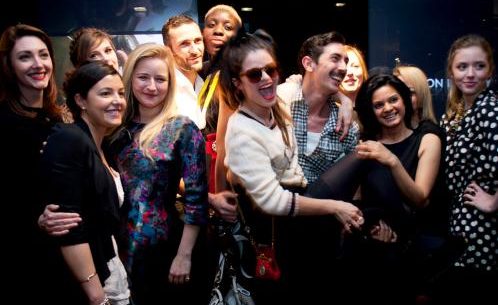
Blog party
It started as a hobby, but fashion blogging is now big business. We investigate how bloggers are making money without losing their cool
Launched in May, Nowmanifest is calling itself the world’s first “superblog”, a coalition of three leading bloggers under one virtual roof. The blogger Bryan Grey-Yambao of Bryanboy (who has a Marc Jacobs bag named after him, the BB Ostrich) and his friend Rumi Neely of Fashiontoast, (the recent star of a viral Ralph Lauren fragrance ad) have teamed up with Sweden’s Elin Kling of Style by Kling (who designed a collection for H&M earlier this year). The message for the naysayers who dismiss the fashion-blogging phenomenon as a flash in the pan is clear: not only are these bloggers commenting on fashion, they are becoming stars themselves — naming handbags, starring in ads and even designing products.
The former fashion journalist Sasha Wilkins pens the hugely successful Liberty London Girl blog. As she sees it, blogging is a whole new arm of the fashion industry. “I’ve just signed with an agency to broker and handle my bookings. If you’d told me four years ago I’d be in this position, I’d have thought you were on crack,” she says. “But just this month I’ve headlined the Club Monaco Blogger Style workshop at Browns, styled a Dolce & Gabbana window on Bond Street, covered Singapore Fashion Festival and been paid to attend the Asia Fashion Summit.” Earlier this year she was invited to the Chanel couture show in Paris, was flown to Moscow by Mango and spoke on digital media at the Evolving Influence conference during New York Fashion Week. The Proenza Schouler designer Jack McCollough was also there, and said: “Blogs posting things about us, going viral and spreading the word over the internet — it has an extraordinary impact on the business.”
Although many of these style queens started their blog as a bit of fun or something to do in their spare time, they are now finding it has become a main source of income. Laetitia Wajnapel of Mademoiselle Robot has 300,000 hits a month. “I started out thinking it would just be something fun to do, but when brands such as French Connection started coming to me for advice about how best to reach new customers through blogs, it became apparent I could grow it into something more,” says Wajnapel, who earns in excess of £40,000 a year from consultancy and related projects.
Readers can tell if you’re selling yourself to anyone and everyone and they’re very vocal about it “By turning a blog into a brand there is an income to be made,” Wilkins says. “But it comes from the opportunities associated with the brand, not from the blog itself, which usually serves as a platform for other things, be it consultancy, books, public speaking or endorsements.” The blogger Bip Ling is the British face of the American brand Forever 21, while the street-style photoblogger Scott Schuman has brought out a book and sells his work for up to £1,200 a print. Then there’s the 15-year-old blogger Tavi Gevinson, who has been hired by the American magazine editor Jane Pratt to create her own online magazine; and the pioneer of the personal-style blog, Susie Lau — aka Susie Bubble — often hosts in-store blogging events for brands such as Topshop.
For some British bloggers, longevity means dancing off the webpage and into retail. The costume design graduate Cait Harrington of Wayward Daughter has launched a small fashion label of the same name that already has a waiting list. “I started making myself garments that I couldn’t find elsewhere.
I included these outfits on my blog and I received so many emails asking if I was going to set up shop that I had to consider it.”
“People like Scott Schuman and [the street-style photographer] Garance Doré have set the benchmark, in that, beyond their blogs, they can work on projects like any other working photographer,” Lau says. The Canadian photoblogger Tommy Ton of the Jak & Jil blog has shot ad campaigns for the luxury Asian department store chain Lane Crawford, Sergio Rossi, L’Oréal and Saks Fifth Avenue, and fashion stories for both Japanese and French Vogue.
However, if, as Lau puts it, blogs represent “a very personal depiction of fashion”, then with advertising banners rolling across the screen and business-class flights to cover shop openings being dangled, how easy is it to earn, and keep, the trust of your readers?
“I’m very open with them,” Lau says. “When I left my full-time job, I basically told everyone, ‘Look, you might see an ad next to what you’re reading, but that’s my next rent payment there.’”
“I have never had any pressure to cover brands that advertised on Liberty London Girl,” Wilkins says. “For example, Paul Smith was one of my big advertisers last year through my external ad agency, but the press office won’t acknowledge my existence or even give me Fashion Week tickets.” In the experience of Navaz Batliwalla, aka the British blogger Disneyrollergirl, “readers can tell if you’re selling yourself to anyone and everyone and they’re very vocal about it”.
Wilkins sums it up: “I am very aware that if I ever deviated from the idea that my taste and personal interests are the common thread that pulls it all together, then the blog would lose any authority it possesses or engagement it has with the reader. I would never endorse a brand I didn’t believe in. It would make me and the brand look ridiculous. I’ve just finished a project with Club Monaco — and I’ve worn the brand since 1994 — so why not work with them? Seems like a perfect fit to me.”
Well, quite. And if they’re also willing to pay for the privilege, then it’s win-win, right?
[ssba]
